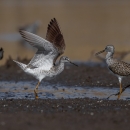Lesser Yellowlegs are a commonly occurring shorebird within Kanuti Refuge. In 2019 we partnered with the Alaska Migratory Birds Office to serve as a study site as part of a multi-partner investigation of migratory movements of Lesser Yellowlegs breeding at six sites across boreal Alaska and Canada. We captured and GPS-tagged 10 adult yellowlegs on the refuge and monitored their movements, with some wintering as far south as Argentina. We are currently pursuing a study of the adult survival of yellowlegs breeding near the Kanuti River.
Learn more! Visit the U.S. Fish and Wildlife Service Alaska Medium page to read the blog article, "A Day in the Life of a Lesser Yellowlegs." Want an immersive experience for this story instead? Experience it in a story map!
Read more:





